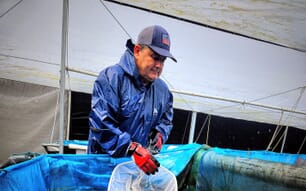Tilapia Oreochromis niloticus culture has been growing at an outstanding rate during the past decade in most of the tropical, subtropical and temperate regions.
In addition, tilapia culture has been gradually shifted from the traditional semi-intensive systems to the more intensive systems, which rely exclusively on artificial feeds. Therefore, formulating economic tilapia feeds has become a necessity.
Nutrition represents over 50 per cent of total culture financial inputs in tilapia aquaculture, but the prices of major feed ingredients including fish meal, soybean meal, corn, bran and oils have been sharply increasing during the past few years. This is due to increased demand for crops and competition with the biofuel industry.
Therefore, the major challenge facing tilapia aquaculture industry is the production of cost effective and environmentally performing feeds for farmed tilapia, using inexpensive, locally available ingredients.
Date palm tree is one of the most important cultivated trees in arid and semi-arid regions, especially in North Africa and Arabian Gulf countries. Date fruits play an important role in the economies of these countries, as a major source of nutrition.
Date wastes include date stones and date fibre, with a substantial amount produced each year. These by-products may have high potential as energy sources for farm animals and farmed fishes.
Date fibre (date fibre), a by-product of date syrup production, is an insoluble, powder-like, non-nutritive portion of the date flesh. It is composed mainly of cellulose, hemicelluloses, lignin, ligno-cellulose, and insoluble proteins.
This fibre is naturally broken down, by enzymes, during the ripening process, to more soluble compounds (glucose, sucrose, mannose and soluble pectin and glactomanan) to render the fruit more tender and soft. Date fibre represents 20-100 g kg-1 of the date flesh, depending on the type and quality of the dates.
Only a few studies have been carried out to investigate the use of this by-product as a feed ingredient in rats and in human food fortification. They reported that burger formula replaced with up to 150g per kg date fibre produced healthier and better quality beef patties by possessing hypolipidemic effects.
Dietary fibres, particularly water soluble, might influence lipid metabolism in rats, as it was found to possess hypolipidemic effects in rats fed 2 g kg-1 cholesterol. Additionally, date fibre concentrates showed a high water and oil holding capacity.
The present study was conducted to investigate the use of date fibre as a replacement of dietary wheat bran in the diets of tilapia fingerlings, looking at growth and proximate body composition.
Additionally, the effect of date fibre on pellet quality in terms of pellet strength, total and specific bacterial count, and anatomical alterations of the intestinal villi of the fish were investigated.
Four isonitrogenous isocaloric diets containing 0, 100, 200 and 300 g kg-1 date fibre as replacement of wheat bran were fed to triplicate groups of ten O. niloticus fingerlings (0.65 g) in a recirculating water system for 70 days.
Fish fed diets containing up to 200 g kg-1 date fibre had similar growth parameters, despite the nutrient content of the base wheat bran being higher than the date fibre. This shows that adding some date fibre to tilapia feed did not significantly affect the fish, similar to results previously seen in common carp.
These effects may have been aided by increased nutrient absorption by the fish when fed the meal with date fibre added, as they showed an increase in number, size and thickness of their intestinal villi.
However, a further increase in dietary date fibre to 300 g kg-1 resulted in significant retardation in all parameters. This may have been due to a reduction in feed intake as the fish may not have been able to utilise the high fibre levels.
Body fat was reduced while protein, ash and moisture were increased by date fibre level. Increasing dietary date fibre level caused changes in tilapia’s intestinal villi, reduced dietary microbial activity and bacterial population of selected species, and produced stronger pellets.
Date fibre inclusion in the test diets produced stronger pellets which were indicated by that reduction of powder after grinding.
In conclusion, the present study suggests 200 g kg-1 of dietary wheat bran in tilapia feeds can be replaced with date fibre without having negative effects on tilapia. This replacement could lead to a significant reduction in feed costs.
July 2015




